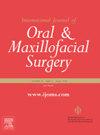Aberrant promoter methylation of CTHRC1 gene and its clinicopathological characteristics in head and neck cancer
IF 2.2
3区 医学
Q2 DENTISTRY, ORAL SURGERY & MEDICINE
International journal of oral and maxillofacial surgery
Pub Date : 2025-01-25
DOI:10.1016/j.ijom.2025.01.005
引用次数: 0
Abstract
Head and neck squamous cell carcinoma (HNSCC) is genetically complex and difficult to treat. Detection in the early stage is challenging, leading to diagnosis at advanced stages with limited treatment options. This study examined the collagen triple helix repeat containing 1 gene (CTHRC1) as a potential biomarker and therapeutic target in HNSCC. Despite documented CTHRC1 upregulation in various cancers, the underlying causes remain unclear. The objective was to investigate potential epigenetic regulation of CTHRC1 expression through the analysis of promoter methylation. CTHRC1 DNA methylation, mRNA, and its protein expression were analysed using The Cancer Genome Atlas (TCGA) HNSCC cohort and oral squamous cell carcinoma (OSCC) patient samples. Functional analysis included scrutinizing the protein–protein interaction network and associations with DisGeNET (disease gene network). Various statistical methods were employed for analysis. HNSCC tumours exhibited significant hypomethylation of CTHRC1 DNA, correlating with advanced disease features. Elevated mRNA and protein expression of CTHRC1 further support its role in disease progression. High CTHRC1 gene expression was associated with a poorer prognosis. The protein interaction network implicated crucial pathways in cancer development and links to oral submucous fibrosis. Despite the limitations of this study, including the use of retrospective data and need for functional experiments, CTHRC1 shows potential as a prognostic predictor and target for therapeutic applications in HNSCC, paving the way for further research and improved patient management.
头颈癌CTHRC1基因启动子甲基化异常及其临床病理特征
头颈部鳞状细胞癌(HNSCC)是一种遗传复杂且难以治疗的疾病。早期发现具有挑战性,导致晚期诊断和有限的治疗选择。本研究检测了胶原蛋白三螺旋重复序列(CTHRC1)作为HNSCC潜在的生物标志物和治疗靶点。尽管有文献记载CTHRC1在各种癌症中上调,但其根本原因尚不清楚。目的是通过分析启动子甲基化来研究CTHRC1表达的潜在表观遗传调控。采用癌症基因组图谱(TCGA) HNSCC队列和口腔鳞状细胞癌(OSCC)患者样本分析CTHRC1 DNA甲基化、mRNA及其蛋白表达。功能分析包括仔细检查蛋白质-蛋白质相互作用网络以及与疾病基因网络(DisGeNET)的关联。采用多种统计方法进行分析。HNSCC肿瘤表现出显著的CTHRC1 DNA低甲基化,与晚期疾病特征相关。CTHRC1 mRNA和蛋白表达的升高进一步支持其在疾病进展中的作用。高CTHRC1基因表达与较差的预后相关。蛋白质相互作用网络涉及癌症发展的关键途径,并与口腔粘膜下纤维化有关。尽管本研究存在局限性,包括回顾性数据的使用和功能实验的需要,但CTHRC1显示出作为HNSCC治疗应用的预后预测因子和靶点的潜力,为进一步研究和改善患者管理铺平了道路。
本文章由计算机程序翻译,如有差异,请以英文原文为准。
求助全文
约1分钟内获得全文
求助全文
来源期刊
CiteScore
5.10
自引率
4.20%
发文量
318
审稿时长
78 days
期刊介绍:
The International Journal of Oral & Maxillofacial Surgery is one of the leading journals in oral and maxillofacial surgery in the world. The Journal publishes papers of the highest scientific merit and widest possible scope on work in oral and maxillofacial surgery and supporting specialties.
The Journal is divided into sections, ensuring every aspect of oral and maxillofacial surgery is covered fully through a range of invited review articles, leading clinical and research articles, technical notes, abstracts, case reports and others. The sections include:
• Congenital and craniofacial deformities
• Orthognathic Surgery/Aesthetic facial surgery
• Trauma
• TMJ disorders
• Head and neck oncology
• Reconstructive surgery
• Implantology/Dentoalveolar surgery
• Clinical Pathology
• Oral Medicine
• Research and emerging technologies.

 求助内容:
求助内容: 应助结果提醒方式:
应助结果提醒方式:


